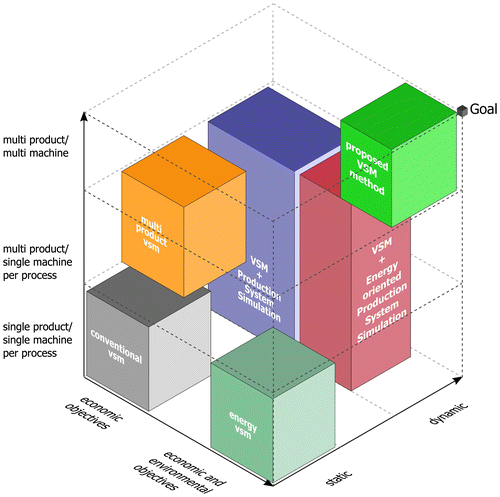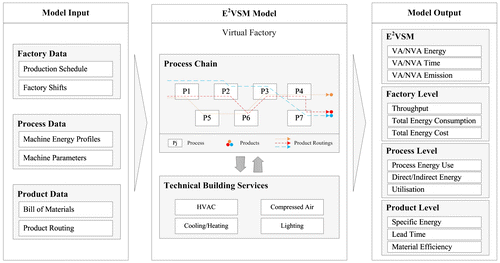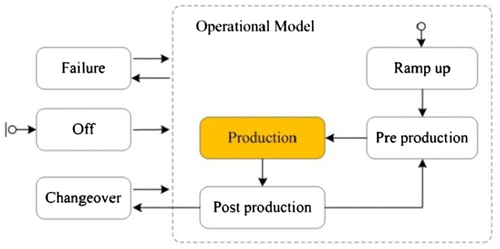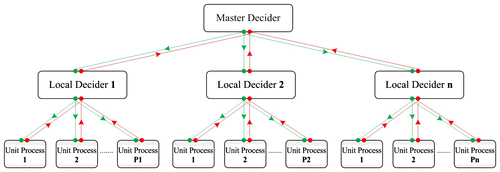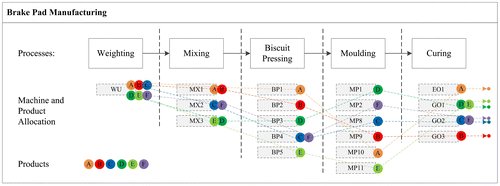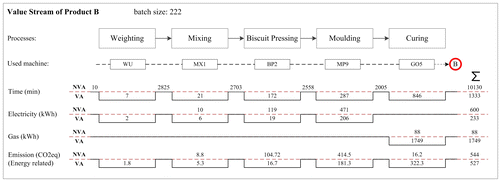Abstract
Value stream mapping (VSM) is a well-accepted tool within lean manufacturing concept which is often used for analysing and designing the flow of materials and information required to manufacture a product. However, the analysis is static and single product oriented, which fails to cope with either the variation of production plan or a multi-product environment. In addition, the environmental impact of a manufacturing system is highly associated with the dynamic consumption of energy and resources. Despite the recent integration of VSM with simulation or environmental studies (in the domain of energy efficiency), still neglected is the dynamic assessment of all the resources involved in a multi-product production environment. This paper presents a methodology for modelling multi-product manufacturing systems with dynamic material, energy and information flows with the aim to generate economic and environmental value stream maps (E2VSM). The proposed methodology is validated with an industrial case.
1. Introduction
The manufacturing industry is under high pressure to improve and maintain product quality and process performance under stringent environmental and safety regulations. Additionally, emerging requirements for the reduction in environmental footprint, material, energy and water consumption have added to these pressures. Companies are more eager than ever to find tools that facilitate their efforts in improving their manufacturing systems regarding their economic and environmental performance.
Lean manufacturing is a systematic approach that strives to improve production performance through elimination of waste. Value Stream Mapping (VSM) is known as a primary and user-friendly method to apply lean principles within a manufacturing environment (Rother and Shook Citation2003). It is a paper-pencil method using standardized figures and icons for the representation of a product’s value stream and all its activities, highlighting the value adding and non-value adding processes. While VSM is a useful method for identifying waste and improvement potentials regarding traditional manufacturing objectives such as lead time and work in progress, it is not capable enough to be used in comprehensive analysis of production systems:
| • | VSM is limited to the representation of one product or product family flow; | ||||
| • | VSM only provides a static snapshot view of the process chain; | ||||
| • | VSM is a simplified representation of the process chain with no consideration of energy and resource consumption from the environmental perspective. | ||||
In order to overcome those limitations, this paper presents a methodology for modelling dynamic material, energy and information flows in a multi-product manufacturing system with the aim to generate economic and environmental value stream maps (E2VSM). The structure of this paper is as follows: Section 2 gives a critical review about the development of VSM found in theory and practice; Section 3 presents a systematic approach on dynamic modelling of E2VSM for multi-product systems; Section 4 provides a case study to demonstrate the proposed methodology followed by a conclusion and outlook.
2. Critical review of VSM development
Despite the popularity of using VSM to practice lean manufacturing, VSM has often been criticized due to the lack of the ability to cope with a multi-product manufacturing system, dynamic changes of the system, as well as the flows associated with the environment concerns (e.g. energy flows). Over the last decade, different researchers have attempted to overcome some of the aforementioned shortcomings.
2.1. From single product to multi-product
Within conventional VSM, processes are normally characterized with constant cycle times and processing times, based on average values or one-time measurements (Lian and Van Landeghem Citation2007). Especially when a value stream map is created for one product family, only average values can be used. Such characteristic makes VSM perfectly applicable to mass production systems with little variety in the product mix but limits its application on high-mix and low-volume manufacturing environments (Gurumurthy and Kodali Citation2011). This shortcoming is addressed in some approaches by modelling a multi-product flow (Braglia, Carmignani, and Zammori Citation2006; Agyapong-Kodua et al. Citation2012). However, like traditional VSM, these approaches only represent the value stream in a static manner and only provide a snapshot of the production flow, ignoring interactions among different jobs of products. In addition, the set-up time, processing time and routing through the production system is normally product specific, resulting in variations in lead time and utilization of resources for different product types (Schönemann et al. Citation2014). As a result, the conventional VSM for one day of production is not necessarily a valid representation of the actual overall system behaviour (Parthanadee and Buddhakulsomsiri Citation2012). Knowledge about the dynamic system behaviour is further essential for a what-if analysis of improvement measures and changes in a future state production system.
2.2. From static to dynamic
As a solution for enabling what-if analysis, discrete event simulation has been added to conventional VSM by a number of researchers. For example, McDonald et al. (Citation2002) developed simulation models of manufacturing systems in order to analyse and visualize the dynamic states of both unit processes and the entire system. Simulation models in general have also demonstrated the capability of evaluating different future state maps without interrupting the current production (Parthanadee and Buddhakulsomsiri Citation2012). Solding and Gullander (Citation2009) presented a concept for creating dynamic value stream maps by using simulation. A die casting factory was simulated considering 13 different products with different parameter settings. A spreadsheet represented the results of the simulation runs in a VSM manner. Shararah et al. (Citation2011) presented a VSM simulator and analysed traditional economic measures such as inventory levels, lead time and utilization. However, the work focused on a single product production environment and the environmental evaluation of the production processes was not included.
2.3. From single objective to economic and environmental objectives
During the last few years, the principles of lean management have been adapted towards a “lean and green” philosophy. The VSM methodology has also been extended to the energy VSM (EVSM) in order to identify the main energy consumers in a production line. Erlach and Westkämper (Citation2009) proposed an assessment of process energy within VSM by calculating the energy intensity (EI) of a process. However, the calculation is based on the average power demands of production machines with no consideration of dynamic energy profile of the production machine. Gutowski et al. (Citation2005) have shown that the energy profile of the machine can be subdivided into fixed and variable energy consumption. The energy requirement of machine components contributes to the fixed energy consumption whereas the actual operation (e.g. cutting) of a production machine contributes to the variable consumption. Bogdanski et al. (Citation2013) extended the EVSM approach by considering variable energy consumption of the machine at three distinctive states: process, idle and ramp up. Also, their model proposed a product-specific energy VSM incorporating influences of product design characteristics. Müller et al. (Citation2014) also presented an EVSM approach to differentiate between value and non-value adding energy inputs.
However, the aforementioned approaches were applied separately on each product type, hence neglecting the dynamic and stochastic interrelations between different products and processes. Moreover for determination of energy costs, average power demands of manufacturing processes are not sufficient since energy cost calculation does not only depend on the amount of energy used, but also depends on the peak load of the factory (Herrmann et al. Citation2011). It is important to analyse the occurrence of peaks in the energy demand resulting from the simultaneous usage of different production resources and superposition of machine states with high power demands (e.g. ramp up). Some studies considered the indirect energy demands – energy demands of auxiliary processes as well as the energy demands of (e.g. heating, lighting and air conditioning). The influence of technical building services (TBS) which indirectly contribute to making a product was studied in a recent work by (Posselt et al. Citation2014). A model of a multi-product process chain with sequential processes was presented, not considering the dynamics of energy and material flows within the process chain and individual processes. Apart from energy consumption, Sproedt et al. (Citation2011) and Plehn et al. (Citation2012) incorporated environmentally relevant process parameters with the VSM model and applied environmental impact assessment of input and output flows.
2.4. Research gap and aim
In summary, Figure presents an overview of recent developments from the conventional VSM. In moving towards sustainability in manufacturing, it is essential to have a holistic perspective of the dynamic flow of resources and their associated environmental impacts from unit process, process chain, through the whole manufacturing system. Although data and information for individual product types can be measured and used for static calculation, the dynamic and stochastic interrelations between jobs and resulting lead times, energy demands and peaks on factory level (including auxiliary processes and technical building services) can only be assessed using simulation techniques. The multi-product/multi-machine environment with various products routing and machine job sharing further add challenges to this task. Aforementioned researches and practices have provided valuable foundations to overcome the main limitations of conventional VSM to a certain extent. A clear research gap has been identified and highlighted in the right top side of Figure . Therefore, the research motivation is to extend the conventional VSM methodology towards the dynamic evaluation of economic and environmental objectives for multi-product manufacturing systems.
3. Economical + Environmental VSM methodology
Figure presents the structure of the proposed methodology for modelling multi-product manufacturing systems with dynamic material, energy and information flows. The main aim is to generate economic and environmental value stream maps (E2VSM). The core of the methodology is a simulation-based model with multi-product/multi-machine scope, which enables what-if analysis for improvement measures. The model requires input information from different levels to configure the virtual manufacturing system. Correspondingly, the model generates a number of indicators at different levels as the model output for further E2VSM presentation.
3.1. E2VSM model input
The E2VSM model requires various input data about the factory, processes and products. These data can be drawn from available information systems such as ERP (Enterprise Resource Planning) and SCADA (Supervisory Control and Data Acquisition) systems. Due to unavailability of data, additional metering and recording efforts (e.g. energy metering) are normally unavoidable when initially configuring the simulation model. It is worth noting that more detailed initial data tend to lead to more accurate simulation results. The following paragraph discusses the model input that is required in order to achieve a valid model.
At the factory level, data about production schedules and shifts are required to determine the sequence of jobs and the available time for production. Disregarding the differences in production scheduling strategy (pull/push/pull-push), either forecasting demands or actual customer orders are transferred into a detailed job sequence at the beginning of each process chain. This information can normally be obtained from production planners or production managers. First-in first-out (FIFO) is used at each unit process for handling different jobs.
At the unit process level, process data are used to describe the behaviour of the available manufacturing processes. In particular, machine-specific parameters (e.g. set-up and processing times and mean time between failures) and machine energy profiles are highly relevant to derive the energy consumption and the associated environmental impact.
From the product perspective, the Bill of Materials (BOM) provides essential information to quantify the material flows, such as material input mass and material type. The machine-specific parameters (e.g. quality rates and scrap rates) are also important input parameters for this purpose. Notably, some of the data – for example the processing times and the energy consumption of machines – are influenced by the characteristics of the processed products. The product characteristics, attributes of the materials and subcomponents are described by the BOM . Furthermore, the routing of products determines the processes and resources used at each process step.
3.2. E2VSM logic
The E2VSM model contains the logic for the determination of the material and energy flows in a multi-product manufacturing system. Both material and energy flows are characterized in a dynamic manner according to the process and product characteristics. A generic model platform is developed using Discrete Event Simulation (DES) in the AnyLogic® model development environment. As illustrated in the centre of Figure , the E2VSM model takes a holistic view of the factory, representing the manufacturing system in terms of two interactive modules: process chains and TBS.
3.2.1. Process chain module
The process chain is configured by linking the unit processes which are responsible to transform the material into the valuable product. Each unit process is characterized by the corresponding machine specific parameters (e.g. energy profile, scrap rate, etc.). Basic unit process modules for the representation of machines are created by using state charts. Seven operational states are defined with each state consuming different amounts of energy and auxiliary material (Figure ).
The definition of each state is described in the following:
| • | Off: refers to the state when the machine is switched off at the end of the production shift. | ||||
| • | Ramp up: refers to the acceleration of the main component when switched on before the actual production; normally results in a power surge. | ||||
| • | Standby: refers to the period when the machine remains ready for production; normally shows a constant or fixed power pattern. | ||||
| • | Preproduction: refers to the period when the positioning of the work piece on the machine is performed. | ||||
| • | Production: refers to the state when the machine is processing the material. | ||||
| • | Postproduction: refers to the state when the machine’s auxiliary equipment (e.g. lubrication pump, chip remover) is activated after the main production. | ||||
| • | Changeover: refers to the state when the machine is being set-up for producing a different product. | ||||
| • | Failure: refers to the state that the machine breaks down and requires repairs or maintenance. | ||||
The dynamic flow of materials and energy to and from machines is approximated by the parameterization of the states. Following the nature of DES, state changes are triggered by discrete events. For example, the event “order arrived” switches the machine from “Standby” state to “Production” state. The duration of some states (e.g. the ramp up time) also needs to be initially configured. Other parameters like changeover time and batch size are also dependent on the type of processed product.
In order to model a multi-product environment, generic master and local deciders are developed to deal with product routing and machine allocation. Conceptually, the multi-product environment consists of various process steps, and each process step has one or multiple unit processes. Accordingly, the master decider assigns each product to the correct process step, and the local decider allocates that product to the specific unit process (follow green arrows in Figure ). Notably, the arrows shown in Figure represent the information flow, not the entity. Once the job is finished at the unit process, the “job finished” message is transmitted all the way from the unit process through the local decider to the master decider (follow red arrows in Figure ). Then, the master decider will assign the product to the next process step. This information loop is repeated until the product goes through all process steps. As for the model input, the production plan and product routing are exported into an excel spreadsheet, which interface with the main simulation platform. The production plan contains the order quantities and product types. Inputting production plans and routings through Microsoft Excel ®excel sheets provides a high degree of flexibility and ease of use. Specially for conducting what-if analysis, the user can easily modify the input parameters (routing, production plan) on the spreadsheet without the need to perform any changes on the simulation platform.
3.2.2. TBS module
The process chain requires other resources and auxiliary services such as lighting, heating and compressed air that are provided by TBS. Within the E2VSM model, the TBS modules simulate the dynamic behaviour of periphery devices, such as HVAC and boilers, etc. Like production processes, the periphery devices have different operational states, such as ramp up, standby, production, ramp down and off. The production load on these devices is dependent on the total resource requirement of associated production processes that is configured by the machine specification. Owing to the great flexibility of AnyLogic®, several developed TBS models can be directly connected into the proposed E2VSM model, such as the compressed air system model (Mousavi et al. Citation2014). As a whole, the TBS system contributes to a significant share of energy consumption at the factory level. However, it is challenging to allocate TBS energy consumption to each product and process, since TBS is normally shared by multiple unit processes at the same time. Moreover, the standby energy consumption of TBS is not directly associated with any product or process. For the purpose of simplicity, this paper excludes the direct allocation of TBS energy consumption to products and processes, and considers it at the factory level.
3.3. Model output
The proposed simulation model generates E2VSM for each product as well as other performance indicators at different levels (i.e. factory, unit process and product), as shown in Figure . The E2VSM output includes the traditional VSM indicators for different products such as process value-added/non-value-added times, inventory levels as well as environmental related indicators such as value-added/non-value-added energy and related emissions. E2VSM output provides ample data for running comparison analysis between different products.
Examples for other indicators at factory level are total energy consumption (direct and indirect) of the factory and subsequently total energy cost as well as throughput rate. All the aggregated data on the factory level can be tracked back to its origin (e.g. unit process or TBS). At the unit process level, equipment utilization such as percentages of machine states (on, off, standby, break down) are estimated and used as the basis for energy calculations. In this context, only the production state is considered as the value adding (VA) share, while the other states are all grouped into the non-value adding (NVA) share. The environmental measures such as direct and indirect CO2 emission equivalent for each unit process are estimated based on the energy calculation. Machine capacity data on piece count as well as material consumption rate and scrapped during operations are the examples of output data on this level.
At the product level, the total energy and resource consumption for manufacturing one product are also determined, such as specific energy consumption and energy cost per part. To be more specific, the VA share is directly recorded for processing a specific product, whereas the NVA share is allocated according to the number of different products produced. Lead time measurement for each product type is also generated determining the percentage of the time spent on value adding or non-value adding operations. The output results establish a solid base for identifying inefficiencies and improvement opportunities.
4. Case study
The developed concept was exemplarily applied to a real multi-product manufacturing system, which produces composite brake shoes and disc pads for the railway industry. The analysed company offers around 100 different products, which can be generally grouped into three product families. These products differ in terms of various material composition and shape. In this case study for demonstration purposes, among the generated results for all the products, the results for six of the high demanded products are selected and tabled for discussion.
4.1. E2VSM model development
The model development started with mapping the process flows as shown in Figure . The process chains of all products mainly include five different process steps: weighting, mixing, biscuit pressing, moulding and curing. At each process step, different machines are available which are used for specific product according to the product routing. At the first process step, there is only one weighting unit (WU) for scaling the raw materials according to a specific recipe. In the next step, one of three mixers (MX) is used to generate the friction material compound. Then, one of five biscuit presses (BP) pre-forms the mixed friction material into cuboid biscuits. Afterwards, a set of pre-formed biscuits (varying from two to eight) are heated and moulded in one of the six moulding press units (MP). In the end, the products are cured for a certain time in one of the four curing ovens (CO) which uses either gas or electricity for heat generation. In the simulated case, the product routing was predetermined by production planner according to product specification and machine technical specification. Figure presents the routing of simulated products.
The Oracle® ERP system in the tested case provided useful input information such as BOM, production schedule and record. Furthermore, the CitectSCADA® system recorded detailed machine-specific values such as scrap rate, machine status, mean time between failure (MTBF) and mean time to repair (MTTR). However, the energy profile of each process was not documented. Thus, energy metering activities were conducted on all processes as well as TBS devices (e.g. air compressors, cooling tower, etc.). For each machine, the average power consumption at each operational state was used to configure its energy consumption behaviour. The scrap rate was recorded on the SCADA system and the average value was taken for the model input. For instance, the average scrap rate of mixer 1 is 1%, which means 100 kg of weighted input material will yield on average 1 kg of scrap, and 99 kg of mixed up semi-product will flow into the moulding process. Table shows an example of model input for configuring the mixing processes. With all the input information, the E2VSM model was configured accordingly and run for a five-week period.
Table 1. Model input for the mixing processes.
4.2. E2VSM model results
The model validation is important at this stage, as it assess the accuracy and reliability of the simulated results. The factory-level indicators (e.g. factory totals energy consumption, total throughput, factory peak demand) were used for this purpose. Since the initial inventory level was set empty, the first week (week 0) was considered as a simulation warm-up period, thus the results of week 0 were discarded. The simulation error is determined by calculating the ratio of the difference between the simulated and actual total electricity consumption to actual total electricity consumption.
Figure shows the comparison between the simulated factory energy consumption and the daily factory energy measurements. The daily simulation error is less than 10% on average. Notably, the first three Saturdays cause the highest difference between 14 to 18%. A close investigation has identified an unscheduled production on the curing ovens that has been carried out on those days which was not included in the simulation.
Figure 6. Actual daily electricity consumption of the case factory in comparison with simulation results.
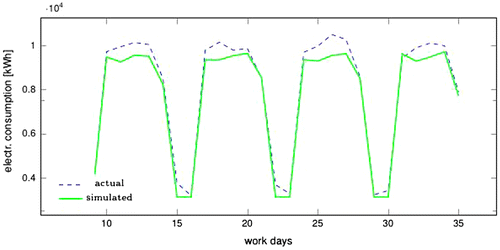
The E2VSM output of the simulation model for multi-product environment is summarized in Table , whereas Figure presents an example of the E2VSM template. Table suggests that there were significant differences among the products in terms of lead time, energy consumption, energy intensity, cost and environmental impacts. The model further determined those indicators in terms of value adding (VA) and non-value adding (NVA) shares. Without an exception, the electrical energy consumption of the NVA share was considerably higher than the VA share. This was due to the long NVA time and the standby energy consumption of the processes. Notably, the specific energy consumption is not solely affected by the batch size, but also influenced by product characteristics, production schedule, machine availability and interaction among different jobs. As shown in table , the proposed E2VSM model is able to consider all the aforementioned factors and apply to a multi-product system in a systematic manner.
Table 2. Simulation results for six products (VA: value adding; NVA: non-value adding).
For the purpose of demonstration, Figure highlights the waste in terms of both time and energy consumption for producing product B. Although the mixing process showed the longest NVA time, the NVA energy consumption was relatively low owing to an extremely low standby power rate (0.22 kW) as shown in Table . In comparison, the NVA energy consumption for the moulding process was the highest one. This is because the moulding machines need to remain a high temperature resulting in a high standby power rate, and these machines are kept on standby between two production shifts overnight.
4.3. An example of what-if analysis
According to the E2VSM, of one batch of product type B in Figure , the curing process consumed the highest energy (1749 kWh). The management suggested conducting a what-if analysis of using alternative process. In the what-if analysis, the gas oven was replaced with the electrical oven (EO1). The curing process time was assumed to be identical in the what-if analysis. Since utilizing an electrical oven instead of gas oven may potentially result in higher energy cost at the factory level due to an increase in the peak power demand, the peak power demand analysis was also studied through the simulation. The simulation model was reconfigured and run for the same period. The results were compared with the above E2VSM of product B. The main difference occurs at the VA period of the curing process, as illustrated in the spider diagram in Figure . As shown in Figure , the value adding energy has been significantly reduced to 381 kWh from the initial 1749 kWh, around 78% reduction. This reduction on energy consumption appears attractive to decision makers at the first place, which means less energy is required to produce the same amount of product. It is important to investigate the impact of this alternative process routing on the environment and cost.
From the environmental point of view, the carbon emission has increased slightly around 4%. This is because natural gas is a comparatively cleaner source of energy (0.1843 kg-CO2eq per kWh gas comparing to 0.88 kg-CO2eq per kWh electricity) (Department of Climate Change and Energy Efficiency Citation2012). In addition, the company’s historic energy bills suggest that the peak power demand charges are almost one-third of the total electricity cost. Similar to the billing method, the peak demand is simulated and recorded as the average power demand in 15 min interval. The result in the spider diagram indicates an increase in the factory peak demand by 3% when using the electric oven which translates to a 3% increase in the total electricity cost. Besides this slight increase in the energy cost, other factors were also considered such as operational costs and quality. Since no additional labour is required for operating the electric oven, there was no significant change observed in terms of operational cost. The product in the electric oven was heated to the same temperature with identical duration as gas ovens, thus the quality of final products should remain the same. Under this circumstance, the management was in favour of increasing the utilization of the electrical ovens. As a result, the electrical oven has been used for more products. At the same time, the case factory was seeking improvement measures for the gas ovens.
5. Conclusion and outlook
This paper presents a methodology for value stream modelling from both economic and environmental perspectives. The proposed E2VSM simulation model considers the dynamic behaviour of multi-product process chains and environmental impacts such as energy consumptions of processes and TBS. The simulation model evaluates the economic and environmental performance of producing each product by visualizing in the E2VSM format. Other performance indicators, from factory to process level, can be generated along with the simulation. The applicability of the E2VSM was examined through a case study. What-if analysis was carried out and the improvement opportunities on the process chain level (future state) were evaluated and compared with the current state of the process chain.
The simulation uses a novel approach to handle the product routing in a multi-product environment, where the Excel spreadsheet is used as an interface for model input. As a result, alternative product routing can be easily assessed during the what-if analysis as shown in the case study. This ease-use feature holds true for all other model input using spreadsheet interface, such as machine power and production plan. As for the configuration of the individual processes, constant values for each operational states (power demand and production times) are currently used within the course of this paper. Due to the flexible modelling platform, other machine configuration options like using probability distribution functions or mathematical equations are possible. Once the E2VSM simulation is constructed, it is easy to use and modify even without having expert simulation knowledge.
The TBS has also been simulated in the proposed E2VSM model. In further model improvements, the physical interaction between unit processes and TBS modules have to be modelled in greater detail in order to increase the model accuracy as well as to improve the allocation of TBS demands to processes and product.
Considering multi-dimensional improvement opportunities and multi-variant nature of the manufacturing systems, further work will focus on the evaluation of combination of the parameters on factory, process and machine level. The goal is to find an optimized set of machines, product routings and process parameters that leads to the best solution towards energy and resource efficient for an entire manufacturing system.
Disclosure statement
No potential conflict of interest was reported by the authors.
Funding
This work was supported by the Australia Research Council.
References
- Agyapong-Kodua, K., J. O. Ajaefobi, R. H. Weston, and S. Ratchev. 2012. “Development of a Multi-Product Cost and Value Stream Modelling Methodology.” International Journal of Production Research 50 (22): 6431–6456. doi:10.1080/00207543.2011.648777.
- Bogdanski, G., M. Schönemann, S. Thiede, S. Andrew, and C. Herrmann. 2013. “An Extended Energy Value Stream Approach Applied on the Electronics Industry.” In Advances in Production Management Systems. Competitive Manufacturing for Innovative Products and Services, edited by C. Emmanouilidis, M. Taisch and D. Kiritsis, 65–72. Berlin: Springer.10.1007/978-3-642-40352-1
- Braglia, M., G. Carmignani, and F. Zammori. 2006. “A New Value Stream Mapping Approach for Complex Production Systems.” International Journal of Production Research 44 (18–19): 3929–3952. doi:10.1080/00207540600690545.
- Department of Climate Change and Energy Efficiency. 2012. Australian National Greenhouse Accounts. Australia: Canberra.
- Erlach, K., and E. Westkämper. 2009. Energiewertstrom – Der Weg zur energieeffizienten Fabrik. Stuttgart: Fraunhofer Verlag.
- Gurumurthy, A., and R. Kodali. 2011. “Design of Lean Manufacturing Systems Using Value Stream Mapping with Simulation: A Case Study.” Journal of Manufacturing Technology Management 22 (4): 444–473. doi:10.1108/17410381111126409.
- Gutowski, T., C. Murphy, D. Allen, D. Bauer, B. Bras, T. Piwonka, P. Sheng, J. Sutherland, D. Thurston, and E. Wolff. 2005. “Environmentally Benign Manufacturing: Observations from Japan, Europe and the United States.” Journal of Cleaner Production 13 (1): 1–17. doi:10.1016/j.jclepro.2003.10.004.
- Herrmann, C., S. Thiede, S. Kara, and J. Hesselbach. 2011. “Energy Oriented Simulation of Manufacturing Systems – Concept and Application.” CIRP Annals – Manufacturing Technology 60 (1): 45–48. doi:10.1016/j.cirp.2011.03.127.
- Lian, Y. H., and H. Van Landeghem. 2007. “Analysing the Effects of Lean Manufacturing Using a Value Stream Mapping-Based Simulation Generator.” International Journal of Production Research 45 (13): 3037–3058. doi:10.1080/00207540600791590.
- McDonald, T., E. M. Van Aken, and A. F. Rentes. 2002. “Utilising Simulation to Enhance Value Stream Mapping: A Manufacturing Case Application.” International Journal of Logistics Research and Applications 5 (2): 213–232. doi:10.1080/13675560210148696.
- Mousavi, S., S. Kara, and B. Kornfeld. 2014. “Energy Efficiency of Compressed Air Systems.” Procedia CIRP 15: 313–318. doi:10.1016/j.procir.2014.06.026.
- Müller, E., T. Stock, and R. Schillig. 2014. “Energy Value-Stream Mapping – A Method to Optimize Value-Streams in Respect of Time and Energy Consumption.” In Enabling Manufacturing Competitiveness and Economic Sustainability, edited by M. F. Zaeh, 285–290. Cham: Springer International Publishing.10.1007/978-3-319-02054-9
- Parthanadee, P., and J. Buddhakulsomsiri. 2012. “Production Efficiency Improvement in Batch Production System Using Value Stream Mapping and Simulation: A Case Study of the Roasted and Ground Coffee Industry.” Production Planning & Control 25 (5): 425–446. doi:10.1080/09537287.2012.702866.
- Plehn, J., A. Sproedt, A. Gontarz, and J. Reinhard. 2012. From Strategic Goals to Focused Eco-Efficiency Improvement in Production - Bridging the Gap Using Environmental Value Stream Mapping. Zürich: Eidgenössische Technische Hochschule Zürich, Institute of Machine Tools and Manufacturing (IWF).
- Posselt, G., J. Fischer, T. Heinemann, S. Thiede, S. Alvandi, N. Weinert, S. Kara, and C. Herrmann. 2014. “Extending Energy Value Stream Models by the TBS Dimension – Applied on a Multi Product Process Chain in the Railway Industry.” Procedia CIRP 15: 80–85. doi:10.1016/j.procir.2014.06.067.
- Rother, M., and J. Shook. 2003. Learning to See: Value Stream Mapping to Add Value and Eliminate Muda. Cambridge, MA: Lean Enterprise Institute.
- Schönemann, M., S. Thiede, and C. Herrmann. 2014. “Integrating Product Characteristics into Extended Value Stream Modeling.” Procedia CIRP 17: 368–373. doi:10.1016/j.procir.2014.01.091.
- Shararah, M. A., K. S. El-Kilany, and A. E. El-Sayed. 2011. “Value Stream Map Simulator Using ExtendSim.” Proceedings of the World Congress on Engineering 2011 I: 755–758.
- Solding, P., and P. Gullander. 2009. “Concepts for Simulation Based Value Stream Mapping.” Simulation Conference (WSC), Proceedings of the 2009 Winter: 2231–2237. doi:10.1109/WSC.2009.5429185.
- Sproedt, A., J. Plehn, C. Schneider, and P. Schönsleben. 2011. “Integrated Environmental and Economic Assessment of Production Systems Using a Material Flow Simulation Model.” In Enabling Manufacturing Competitiveness and Economic Sustainability, edited by H. ElMaraghy, 415–421. Berlin: Springer-Verlag.

